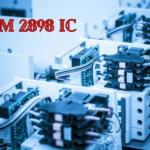WebCord Virus: What You Need to Know
You know how the online world is like this vast, interconnected universe, right? Well, in this cyber galaxy, there’s this thing called the Webcord virus. And let me tell you, it’s not your average digital bug. Nope, this sucker is a serious threat, not just to regular folks like you and me, but to big networks and systems too.
So, why should you care? Well, understanding what makes this virus tick is crucial. It’s like learning the enemy’s playbook so we can defend ourselves better. Plus, knowing how to spot and handle it can save us a ton of headaches down the line. So, let’s dive in and unravel the mysteries of the Webcord virus!
Why WebCord Virus?
The name WebCord Virus stems from its distinctive characteristic – its intricate, net-like structure within infected systems. This name captures the essence of the virus, highlighting its web-like presence as it infiltrates and spreads through digital networks. Just as a cord connects different elements together, the WebCord Virus binds itself to various parts of a system, weaving a complex network of infection. So, in essence, the name serves as a fitting descriptor of the virus’s modus operandi, reflecting its interconnected and pervasive nature within the digital landscape.
WebCord Virus: A Closer Look
Imagine a digital realm where a virus lurks, weaving its intricate web across infected systems. That’s the Webcord Virus for you, named after its tangled, net-like structure. It first surfaced back in 2021, and since then, it’s been evolving at breakneck speed.
Evolutionary Journey
Like a shape-shifting villain in a cyber thriller, the Webcord Virus has undergone multiple transformations over the years. With each new version, it gets smarter, sneakier, and deadlier. This evolution isn’t just some random mutation—it’s a calculated response to the ever-changing landscape of cybercrime. The folks behind this virus are constantly tweaking its code, staying one step ahead of security measures and exploiting weaknesses in both software and human behavior.
The path of infiltration
Now, let’s talk about how this sneaky bug finds its way into our digital lives. The Webcord Virus doesn’t just rely on one method—it’s got a whole arsenal of tricks up its sleeve. From shady websites to phishing emails and sketchy downloads, it uses every trick in the book to worm its way into unsuspecting systems. Sometimes, it masquerades as legitimate software, luring people into clicking on innocent-looking links. It’s like a digital chameleon, blending into its surroundings until it strikes.
So, the next time you’re cruising the web, keep an eye out for any signs of the Webcord Virus. It may seem harmless, but trust me, this little bugger packs a nasty punch.
WebCord Virus Explained: A Look at its Features and Impact
Let’s peel back the layers and get to know the Webcord Virus from the inside out.
Behavioral patterns
Once this sneaky bug finds its way into a system, it doesn’t just sit there twiddling its digital thumbs. Oh no, it’s got a whole playbook of behaviors, from siphoning off data to taking control of devices. By studying these patterns, cybersecurity experts can figure out how it operates and come up with ways to stop it in its tracks.
Encryption Techniques
Here’s where things get really tricky. The Webcord Virus is known for its fancy encryption techniques, making data inaccessible even to the most tech-savvy users and security tools. Decrypting its payloads isn’t a walk in the park—it requires serious cryptographic know-how and sometimes a whole lot of computational power too.
Persistence Mechanisms
But wait, there’s more. This virus is a real survivor. It doesn’t just slink away at the first sign of trouble. Oh no, it digs in its heels with persistence mechanisms like registry changes and fileless execution. These tricks not only help it dodge detection but also make it a real pain to remove. It’s like playing a never-ending game of whack-a-mole for cybersecurity specialists.
So, there you have it—the inner workings of the Webcord Virus laid bare. It’s a formidable foe, no doubt about it. But armed with this knowledge, we can stand a fighting chance against its digital onslaught.
WebCord Virus: Don’t Panic, Here’s How to Get Rid of It
Ready to defend your digital fortress against the Webcord Virus? Here’s how to arm yourself:
Proactive Measures
First things first, let’s talk prevention. It’s all about laying a solid foundation of cybersecurity. Start by spreading the word on safe internet practices. Teach your team and customers to navigate the web with caution—avoiding suspicious links and dodgy downloads like the plague.
Next up, fortify your defenses with top-notch antivirus software. Think of it as your virtual shield, standing guard against digital invaders. And don’t forget to keep those software patches up to date. It’s like reinforcing the walls of your castle, making sure there are no cracks for the Webcord Virus to slip through.
Incident Response Strategies
Now, let’s say the worst happens and you find yourself under attack. Don’t panic—stay cool, calm, and collected. With the right incident response strategies in place, you can minimize the damage and bounce back in no time.
First off, swift detection is key. The sooner you spot the signs of a Webcord outbreak, the faster you can spring into action. Once you’ve identified the threat, it’s time to contain it. Quarantine infected systems, isolate the virus, and stop it from spreading any further.
And finally, when the dust settles, it’s time to pick up the pieces and rebuild. With well-planned recovery protocols, you can get your systems back up and running without missing a beat.
So there you have it—your playbook for defending against the Webcord Virus. Stay vigilant, stay prepared, and together, we can keep our digital world safe and sound.
People Also Ask
What are the symptoms of a WebCord Virus infection?
Symptoms may vary, but common signs include slow system performance, unexpected pop-up windows, and unusual network activity. If you notice any of these, it’s best to run a thorough antivirus scan immediately.
2. How does the WebCord Virus spread?
The WebCord Virus spreads through various means, including malicious websites, phishing emails, and compromised downloads. It can disguise itself as legitimate software or links, tricking users into unwittingly infecting their systems.
3. Can the WebCord Virus be removed?
Yes, the WebCord Virus can be removed, but it often requires advanced antivirus software and technical expertise. It’s essential to act quickly and thoroughly to eradicate the virus and prevent further damage to your system.
4. What should I do if my system is infected with the WebCord Virus?
If you suspect your system is infected with the WebCord Virus, disconnect from the internet immediately to prevent further spread. Then, run a comprehensive antivirus scan to identify and remove the virus. Finally, update your security measures and practice safe browsing habits to prevent future infections.
5. How can I protect my system from the WebCord Virus?
Protecting your system from the WebCord Virus requires a multi-layered approach. Educate yourself and your team on safe internet practices, use reputable antivirus software, keep your system and software up to date with regular patches, and implement strong firewall and intrusion detection systems. Additionally, be cautious when clicking on links or downloading files from unfamiliar sources.
Summary
The WebCord Virus represents a significant threat in the ever-expanding realm of cybersecurity. With its sophisticated evolution, elusive transmission methods, and persistent nature, it poses a formidable challenge to individuals, businesses, and cybersecurity experts alike.
However, armed with knowledge about its origins, behavior, and defense strategies, we can stand resilient against its onslaught. By adopting proactive measures such as education on safe internet practices, robust antivirus software, and swift incident response strategies, we can bolster our defenses and minimize the risk of infection.
Ultimately, vigilance remains our greatest asset in the ongoing battle against the WebCord Virus and other digital threats. By staying informed, remaining prepared, and fostering a culture of cybersecurity awareness, we can navigate the digital landscape with confidence and safeguard our digital assets for years to come.
Don’t Miss
7931 Business Auto Class Code: An In-Depth Overview
Understanding business insurance can often feel overwhelming, particularly when dealing with the specific classifications that influence both coverage and premiums.…
Everything You Need to Know About PAFO eStore
The e-commerce landscape has experienced remarkable growth in recent years, with platforms like PAFO eStore stepping up to fulfill the…
Madskills-Agency.net:The Complete Roadmap to Digital Success
In today’s rapidly evolving digital landscape, a robust online presence is essential for any business looking to succeed. However, for…
Mollar CGT 20750 Drawing: Where Artistic Vision Meets Technological Precision”
The mollar cgt20750 drawing stands as a striking example of creativity and technical mastery, blending artistic innovation with intricate detail.…
Tragic Loss: 3 Brothers Drown in Lake Near Southern Memorial Gardens
On a peaceful day near the Southern Memorial Gardens, tragedy struck when a devastating accident claimed the lives of 3…











